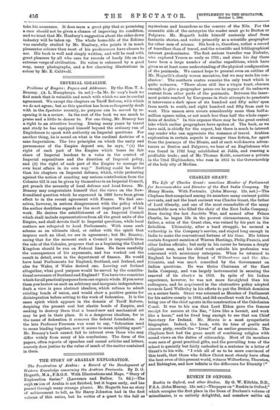mysterious and hazardous as the sources of the Nile. For
the romantic side of the enterprise the reader must go to Burton or Palgrave. Mr. Hogarth holds himself austerely aloof . from fantastic stories, and writes primarily as a scientific geographer for other men of science. His book is, therefore, rather a record of travellers than of travel, and the scientific and bibliographical interest predominates. The first serious traveller was Niebuhr, who explored Yemen as early as 1761; and since his day there have been a large numbcr of similar expeditions, which have given us at least some understanding of the physical configuration of the peninsula. We cannot hope to present even an outline of Mr. Hogarth's closely woven narrative, but we may note his con- clusion-. The southern centre remains the only tract which is quite unknown. "There alone still lies a virgin tract, obscure enough to give a geographer pause ere he argues of its unknown content from other parts of the peninsula. Between the inner- most points reached by Europeans in their attempts to penetrate it intervenes a dark space of six hundred and fifty miles' span from north to south, and eight hundred and fifty from east to west. This unseen area covers considerably more than half-a- million square miles, or not much less than half the whole super- ficies of Arabia." In this expanse there may be the great central lake which earlier geographers have spoken of. The book, as we have said, is chiefly for the expert, but there is much to interest any reader who can appreciate the romance of travel. Arabian exploration in certain aspects is stranger than fiction, for apart from the journeys of the Blunts, and of such well-known adven- turers as Burton and Palgrave, we hear of an Englishman who was found in 1762 long established at Jidda, and running a profitable trade ; and of Mr. Thomas Keith, sometime a private in the 72nd Highlanders, who rose in 1815 to the Governorship of the holy city of Medina.






















































 Previous page
Previous page